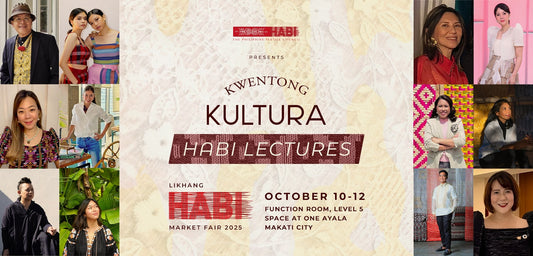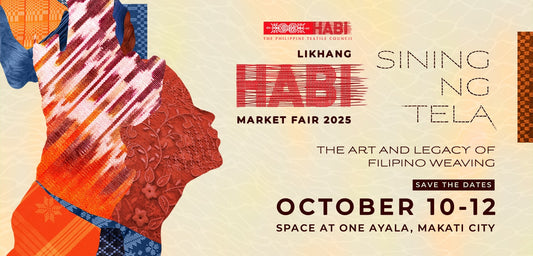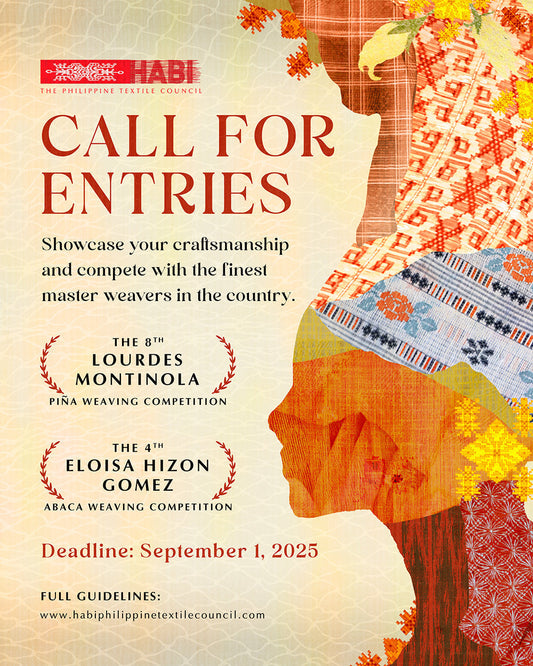Niña Corpuz is the founder and owner of Nina Inabel, a clothing brand that uses indigenous handwoven fabric from Ilocos Norte with the aim of supporting Ilocano farmers and weavers. Below, in her own words, Niña gives us a glimpse of her initial foray into, and ultimate immersion in, the world of weaving.
My friends and I joke about me being an “accidental designer,” but this is so true for me and my brand, Nina Inabel.
I was in broadcasting for the longest time and fashion design wasn’t my background. I never dreamt of one day making my own clothes and, much more, selling them to people who would actually want to buy them! But, eventually, when I retired as a reporter, it became my passion and advocacy.
It all started in 2017, when I could not find children’s clothes for my two girls that represented our culture. I wanted to use pure cotton inabel fabric from my hometown, Ilocos Norte. I wanted the clothes to be wearable and comfortable enough for them to wear every day, and not just as a costume for Linggo ng Wika!

Dr. Joven Cuanang, an art patron, saw my Facebook post of my two girls wearing inabel, the handwoven cloth Ilocos is famous for. He called me and asked me to do a fashion show with another Ilocano designer using inabel. He had just started a project to give livelihood to the weavers in Ilocos Norte and had already established a community that made inabel.
We had a couple of shows and an exhibit showcasing children’s clothes in inabel. Then the parents of these kids—and other friends—started asking me to make clothes for them as well. It just grew from there.
It was very overwhelming, [at first], because I was doing it on my own and couldn’t really cope with the demand. The fabric was also very limited. Once I made a piece, that was it, no repeats even if someone else wanted to order something just like it.
But that’s what sets it apart. The fabric that I use is really a work of art. It is one of a kind. After the weavers have woven one bolt of cloth, they cannot repeat the exact same pattern or design of that bolt.
Motivation
I believe some accidents are meant to be. I was put here for a reason. My background may have been broadcasting; but I grew up with inabel, it was part of my life.
When I started Nina Inabel, it was never about business. What kind of business owner would tell her customers not to buy a lot? Our tagline, “Buy few, live purposefully,” is meant to encourage people to live a sustainable lifestyle and, in this way, naturally help the people around them.
The feeling is priceless when the weavers tell me they are inspired to create more because it also puts food on the table. When we become part of this movement that promotes tradition, makes young people proud of their heritage, and promotes livelihood, life becomes more meaningful.
Design style
Nina Inabel wants to “normalize” the art of wearing indigenous fabric. We want to say you can wear handwoven clothes every day, that it’s cool [to do so]. We hope it becomes a lifestyle.
It’s more than a fashion statement. We design our clothes to be worn by people of all ages for any given occasion—[for shopping at] the mall, a casual weekend, or dinner—basically, [for use] as everyday wear, and not just as a costume for Linggo ng Wika or because you are attending a Filipiniana event.

We stick to classic designs with clean lines. The star here is the fabric itself and the story it represents. I don’t add too many elements or borloloy. When I think of our brand, it’s wearable, functional, classic, and timeless.
On stage with Maria Ressa
The question [of how we were chosen to execute Maria Ressa’s outfit for the Nobel awarding ceremonies] is best answered by Maria’s team. I can tell you that they were very careful in choosing her clothes, so that it not only represents the best of what our country can offer but also Maria’s values and personality.
I was told that my background in journalism was a big factor in their decision for Maria to wear Nina Inabel when she received her Nobel Peace Prize.
I was honored and excited but also nervous because I know she is a perfectionist. It’s fortunate that I had also worked with her for a long time as a journalist (not as a designer) so I knew her personality and sense of style.

Maria is very purposeful in everything she does and that includes what she wears. I knew that if I made something for Maria it had to be classic, elegant, and functional. She’s quite energetic, always on the move, and the type that wears her clothes “forever.” Maria needs something very comfortable but at the same time dignified. She combines these two traits very well, and her clothes have to [reflect] that.
It was such an honor to see a fellow Filipino being recognized on an international level for her values and commitment.
The fact that she wore a piece of Filipino culture, and chose inabel at that, was a clear statement of support for all the weavers and people who champion local, sustainable products.
On a personal level, I was super kilig (thrilled) to see something I made with the local weavers and sewers up on stage for the world to see. It was really quite an emotional moment.
Working with the weavers
[To the question of whether I work with the weavers in designing the fabrics or simply select from what they have produced, my answer is] both.
I use what they produce because I respect their art and creativity. In the town of Pinili, Ilocos Norte, where the oldest weaver is Magdalena Gamayo, the women at the Gamayo Center make their own designs. When you go there, they present their creations with so much pride. On my recent visit, a purple-and-green combination caught my eye. The weaver told me her favorite color is purple so she usually makes them in that color; she was even wearing a purple shirt! It was a joy for me to see her bubbly personality reflected in her weave! She’s an artist and I admire her work, just like the other weavers’.
While they have their own designs, they are also open to my suggestions of the colors and patterns that I want. It becomes a collaboration because they know that I respect their creations.

I focus [mainly] on inabel from the Ilocos region because it is what I know best and what I grew up with. [But], aside from Ilocos Norte, I also get weaves from La Union, Abra, and Ilocos Sur. They all have something different to offer when it comes to design, texture, and thickness.
Promoting cotton farming
We do not only promote weaving but also cotton farming. Dr. Cuanang, whom I work with, has helped a community transform from planting tobacco to planting organic cotton. When the season comes for cotton farming, the farmers use two hectares of land in Pinili, Ilocos Norte. To make it more sustainable, they plan to use a solar-based irrigation system.
Mariano Marcos State University in Batac, Ilocos Norte, is also developing the use of more colors from plant-based dyes that are indigenous to the community.
The use of natural dye and organic cotton from the farm in Pinili has only been recently implemented with the weavers of Sarrat, Ilocos Norte.
The “holy grail”
Dr. Cuanang describes the organic cotton inabel using natural dyes as the “holy grail” of handwoven fabrics. He calls the work that we do “from farm to fabric to fashion.” It’s all a work in progress and there are still some struggles we need to overcome.The dream is to make a sustainable livelihood for the farmers and weavers by giving value to the art and craft of inabel.




